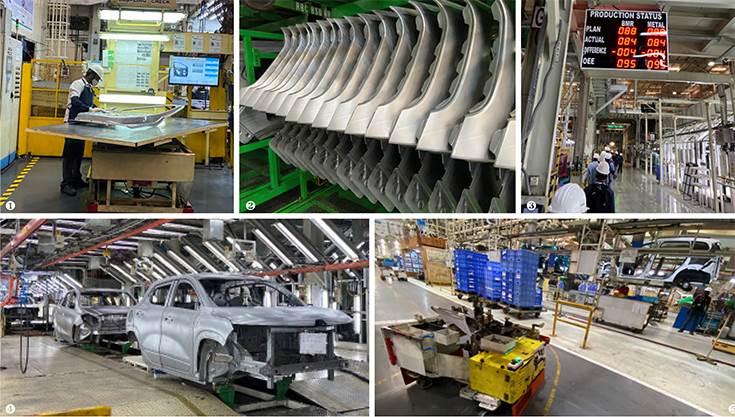Renault Nissan India targets output of 350,000 units by 2026, new midsize SUVs coming in 2025
Having committed $600 million in its next phase of investment, Franco-Japanese alliance Renault Nissan has kicked off work on its midsize SUV programme for the Indian market.
Autocar Professional learns the company has commenced work on projects P1311-R and P-1312-R (codenames for the B+ and C-segment SUVs for Renault) and P1311-N and P-1312-N (Nissan models) catering to the same segment. The alliance partners are targeting combined production volumes of 150,000 units per annum between all four vehicles by 2026, from Renault Nissan Automotive India Pvt Ltd’s (RNAIPL) Chennai plant, for both domestic and exports markets.
Several people in the know of the company’s plans say, the alliance partners are expecting to produce and sell about 350,000 units per annum by 2026. At present, the RNAIPL plant’s annual manufacturing capacity of 480,000 units per annum is underutilised to the tune of nearly 50 percent. As per SIAM data, in the first 11 months of FY2023, the plant has produced a total of 198,545 units, comprising 87,375 units for Nissan Motor India and 111,170 units for Renault India.
Diwali 2025 launch for new midsize SUVs
“The first model based on the CMF-B platform is likely to hit the road in Diwali of 2025. It is likely to be the new-generation Duster from Renault and a Creta rival from Nissan too around the same time. Within six months, a longer version of these models will be launched – around middle of June 2026,” said one of the six people, aware of the company’s plans, requesting anonymity.
The midsize SUVs are likely to be powered by petrol engines as the two OEMs do not plan to localise a diesel or hybrid powertrain. Following an in-depth analysis of India market demand for hybrid powertrain in the coming two years and in the event of potential for good traction of electrified vehicles the alliance partners may import the kit and offer it as a top-of-the-line variant. However, there are no plans of localizing hybrids as yet.
This plan was shared by the alliance partners to its stakeholders in March 2023. The company has maintained its roadmap for introducing an A-segment battery electric vehicle by 2027. The strategy on the shape, form and potential volumes is currently being worked upon albeit the alliance partners may rely on bringing in all-electric CBUs like the Nissan Ariya or Renault Megane to seed its cleaner vehicle portfolio before localised versions are introduced in the marketplace four years from now.
Till the time, all new vehicles are launched, the company will be relying on refreshing the existing models. Exports of the PY1B – the left-hand-drive Magnite – are likely to bring in an incremental volume of 50,000 units output in FY2024, ensuring the cost per unit improves for the manufacturing company.
Both the alliance partners are likely to give their existing portfolio an upgrade coinciding with the six-airbags version, which is due for implementation in October 2023.
An email sent to Renault India did not elicit any response till the time of publishing.
A Nissan Motor India spokesperson said that at this stage, the company cannot reveal or illustrate any specifics that are an outcome of the plan and cannot comment on speculation. He, however, added that “Nissan prioritises the customer’s needs and preferences when developing new vehicles. We are preparing an exciting pipeline of new products that will meet customer aspirations, requirements of local conditions targeting domestic and export markets for sustainable growth.”
In February 2023, the alliance partners announced additional investment of US $600m (Rs 5,300 crore) towards investment in new products and technologies. As per the investment plan, Nissan will introduce three new locally manufactured products – two C-segment SUVs and one A-SUV in the EV segment.
“This significant investment underlines our commitment to the Indian market and our determination to bring the latest technology and innovation to our customers,” added the Nissan Motor India spokesperson.
 Archived images of the Renault Nissan Alliance plant at Oragadam, Tamil Nadu, which has a manufacturing capacity of 480,000 units per annum.
Archived images of the Renault Nissan Alliance plant at Oragadam, Tamil Nadu, which has a manufacturing capacity of 480,000 units per annum.
Ashwani Gupta, Nissan Motor Corporation’s global COO, had announced as part of the company’s new term plan, that Renault Nissan Automotive will take the current plant utilisation levels, which is about 49% at present, to 80% (450,000 units), helped by both domestic and new exports in the next four to five years.
Sharing his expectations to employees in February, Gupta had told them that Nissan’s global market share is 6% and achieving 3% market share in India, which is the third largest market in the world, is “not a big thing” and achieving 80% capacity utilisation “is not a big challenge.”
“Today we are addressing just 15% of the market and securing 1.5% share. If we expand our coverage to 40% – 3.5% market share is doable. I think Nissan can do about 200,000 units of domestic volumes, add export to that and Renault will deliver similar numbers. So making and selling 450,000 cars is no more a dream, I am sure you guys will deliver. If you achieve 3% market share, there will be 225,000 cars, you have another 100,000 units of the exports basket – that is my mathematics,” Gupta had elaborated on his vision for make in India.
